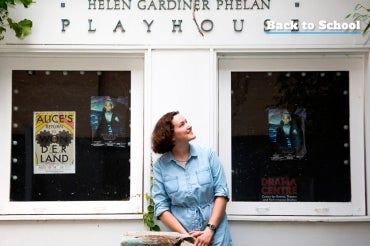#UofTBTS16: Financial supports keep students focused

Published: August 30, 2016
Without academic scholarships offered by the University of Toronto, Marie Trotter would have spent all her free time over the last three years working part-time jobs to pay for school.
The aspiring theatre director would have been unable to pour time and energy into her true passion — drama.
Trotter, who is the executive producer of the UC Follies, the oldest student company on campus, is one of many students who receive financial support to attend U of T. In fact, thousands of U of T students – more than 1,800 from the Faculty of Arts & Science alone – receive help to pay for their academic program.
“I have no doubt that my university experience would be very different without this support,” says Trotter, who has worked part-time jobs since Grade 11 and taken no student loans.
At U of T, spending on student assistance (including needs-based grants, scholarships and fellowships) was estimated to be about $193 million in 2015-2016. Over the years, financial supports for students have increased, going up from $109.9 million in 2007-2008. In addition to U of T’s grants, scholarships and fellowships, students acquired $260 million in loans and grants from the Ontario Student Assistance Program.
This year, the Ontario government announced that low-income students at post-secondary institutions like U of T will be getting their education for free. More than any other university in Ontario, U of T admits a higher percentage of students from families earning less than $50,000.
“There is no doubt in my mind that our dedication to access, while easily justified as a social policy, pays great dividends in quality and diversity,” said University Vice-President and Provost Cheryl Regehr. “We want top performers regardless of their background or financial circumstances. We believe increased access makes us stronger.”
Financial aid from university sources greatly lowers the actual outlay for students facing financial need. The “net tuition” paid by U of T undergraduates who received OSAP was, on average, 51 per cent of the posted tuition rates.
“To be supporting almost half of tuition expenses for so many undergraduates is clearly a remarkable accomplishment,” Regehr said.
For Trotter, who will be going into her fourth year, pursuing a double major in English and drama, her academic scholarships fully paid for her tuition and partially for textbooks and supplies in her first year. Since then, she has received other smaller scholarships over the years that have helped her stave off additional part time work, instead freeing up time for extracurricular opportunities in theatre and drama.
Last year she directed Rope, the 1929 play by Patrick Hamilton that inspired the Hitchcock movie, for the Trinity College Dramatic Society. As part of U of T's work-study program, she is based at the Centre for Theatre, Drama and Performance Studies, helping with the Helen Gardiner Phelan Playhouse. She hopes her drama and theatre experiences will help her build a solid profile that can one day help her land a job as a theatre producer or director.
Students looking for more information about student aid can contact your college or faculty admissions office. Click here and here for more details about government aid, scholarships and bursaries.


